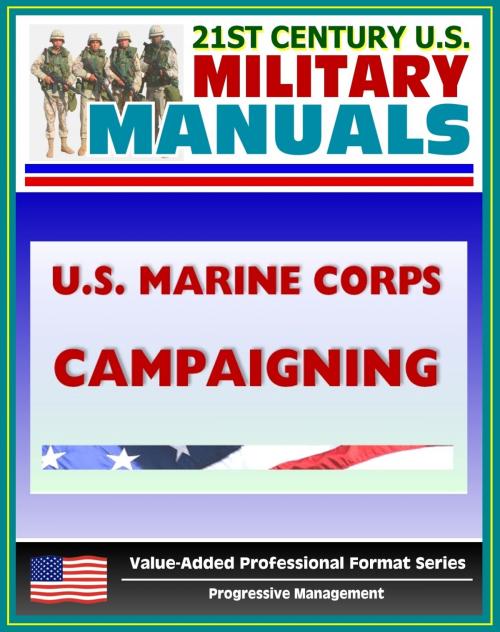21st Century U.S. Military Manuals: U.S. Marine Corps (USMC) Campaigning (Marine Air-Ground Task Force MAGTF) MCDP 1-2 (Value-Added Professional Format Series)
Nonfiction, History, Military, Naval| Author: | Progressive Management | ISBN: | 9781465804235 |
| Publisher: | Progressive Management | Publication: | February 8, 2012 |
| Imprint: | Smashwords Edition | Language: | English |
| Author: | Progressive Management |
| ISBN: | 9781465804235 |
| Publisher: | Progressive Management |
| Publication: | February 8, 2012 |
| Imprint: | Smashwords Edition |
| Language: | English |
Part of our value-added professional format series of U.S. military manuals, this U.S. Marine Corps manual provides the doctrinal basis for military campaigning in the Marine Corps, particularly as it pertains to a Marine commander or a MAGTF (Marine air-ground task force) participating in the campaign. Campaigning applies the warfighting philosophies in MCDP 1, Warfighting, specifically to the operational level of war. It is linked to the other publications of the MCDP series and is fully compatible with joint doctrine.
The new version of Campaigning has three significant additions: an expanded discussion of the linkage between strategic objectives and the campaign, a section on conflict termination, and a section titled "Synergy" that describes how key capabilities are harmonized in the conduct of a campaign to achieve the strategic objective. These additions have been derived from the development of the other doctrinal publications in the MCDP series and joint doctrine.
Chapter 1 discusses the campaign and the operational level of war, their relationship to strategy and tactics, and their relevance to the Marine Corps. Chapter 2 describes the process of campaign design: deriving a military strategic aim from political objectives and constraints, developing a campaign concept that supports our strategic objectives, and making a campaign plan that translates the concept into a structured configuration of actions required to carry out that concept.
Chapter 3 discusses the actual conduct of a campaign and the problem of adapting our plans to events as they unfold.
Central to this publication is the idea that military action at any level must ultimately serve the demands of policy. Marine leaders at all levels must understand this point and must recognize that we pursue tactical success not for its own sake, but for the sake of larger political goals. Military strength is only one of several instruments of national power, all of which must be fully coordinated with one another in order to achieve our strategic and operational objectives. Marine leaders must be able to integrate military operations with the other instruments of national power.
As a bonus, this reproduction includes the Marine Corps Manual, the basic publication of the United States Marine Corps issued by the Commandant of the Marine Corps and approved by the Secretary of the Navy - sold separately for $7.99. It is a regulatory publication for the Department of the Navy as defined in U.S. Navy Regulations. The Marine Corps Manual is designed primarily for use by Marine Corps commanders and their staffs, Navy officers exercising command over Marines, the staff of the Commandant of the Marine Corps, and the staffs of the bureaus and offices of the Navy Department. Contents: Chapter 1 - General Administration And Management * Chapter 2 - Manpower * Chapter 3 - Operations And Readiness * Chapter 4 - Logistics
Part of our value-added professional format series of U.S. military manuals, this U.S. Marine Corps manual provides the doctrinal basis for military campaigning in the Marine Corps, particularly as it pertains to a Marine commander or a MAGTF (Marine air-ground task force) participating in the campaign. Campaigning applies the warfighting philosophies in MCDP 1, Warfighting, specifically to the operational level of war. It is linked to the other publications of the MCDP series and is fully compatible with joint doctrine.
The new version of Campaigning has three significant additions: an expanded discussion of the linkage between strategic objectives and the campaign, a section on conflict termination, and a section titled "Synergy" that describes how key capabilities are harmonized in the conduct of a campaign to achieve the strategic objective. These additions have been derived from the development of the other doctrinal publications in the MCDP series and joint doctrine.
Chapter 1 discusses the campaign and the operational level of war, their relationship to strategy and tactics, and their relevance to the Marine Corps. Chapter 2 describes the process of campaign design: deriving a military strategic aim from political objectives and constraints, developing a campaign concept that supports our strategic objectives, and making a campaign plan that translates the concept into a structured configuration of actions required to carry out that concept.
Chapter 3 discusses the actual conduct of a campaign and the problem of adapting our plans to events as they unfold.
Central to this publication is the idea that military action at any level must ultimately serve the demands of policy. Marine leaders at all levels must understand this point and must recognize that we pursue tactical success not for its own sake, but for the sake of larger political goals. Military strength is only one of several instruments of national power, all of which must be fully coordinated with one another in order to achieve our strategic and operational objectives. Marine leaders must be able to integrate military operations with the other instruments of national power.
As a bonus, this reproduction includes the Marine Corps Manual, the basic publication of the United States Marine Corps issued by the Commandant of the Marine Corps and approved by the Secretary of the Navy - sold separately for $7.99. It is a regulatory publication for the Department of the Navy as defined in U.S. Navy Regulations. The Marine Corps Manual is designed primarily for use by Marine Corps commanders and their staffs, Navy officers exercising command over Marines, the staff of the Commandant of the Marine Corps, and the staffs of the bureaus and offices of the Navy Department. Contents: Chapter 1 - General Administration And Management * Chapter 2 - Manpower * Chapter 3 - Operations And Readiness * Chapter 4 - Logistics















